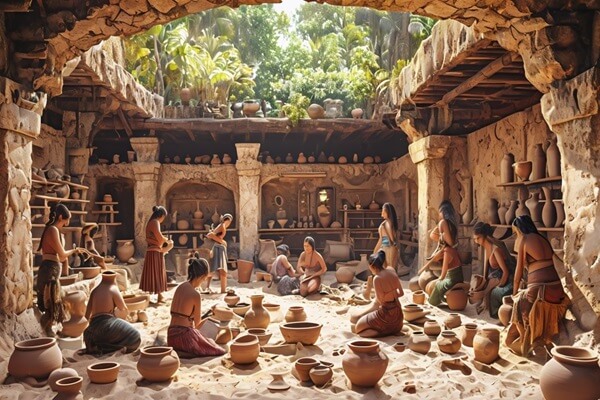Ancient Artz: Where History Meets Creativity

When we think of art, many of us picture modern masterpieces hanging in fancy galleries, but let’s take a step back for a moment. The roots of art stretch deep into history, revealing a colorful tapestry of creativity that has shaped cultures across the globe. Ancient Artz is so much more than just old relics; it’s a vibrant testament to human expression, innovation, and storytelling. So, grab your imagination and let’s dive into the fascinating world of Ancient Artz and explore why it still captivates us today!
What Is Ancient Artz?
First things first—what exactly do we mean by Ancient Artz? Simply put, Ancient Artz refers to the visual arts created long before the fall of the Roman Empire around 476 AD. This includes everything from paintings and sculptures to ceramics and architecture, as well as everyday objects that had artistic significance.
Imagine the intricate pottery of ancient Greece or the majestic stone carvings in the Mayan ruins. These pieces offer a window into the lives of people who walked this Earth thousands of years ago. They reveal what mattered to those civilizations—whether it was the gods they worshipped, the stories they told, or the battles they fought.
The Influence of Ancient Artz on Modern Society
Now, let’s talk about why Ancient Artz still resonates with us today. Ancient Artz works weren’t just pretty decorations; they held deep meanings and served important roles in religious, political, and cultural contexts.
Take the Greek Parthenon, for example. This stunning temple isn’t just a beautiful structure; it symbolizes democracy and civic pride. Fast forward to modern times, and you’ll see its influence in government buildings around the world, all echoing its architectural elegance.
Then there’s Egyptian art, which beautifully depicted gods and pharaohs. Those meticulous carvings weren’t just for show; they conveyed power and beliefs about the afterlife. Even today, many architects draw inspiration from the symmetry and grandeur of ancient Egyptian structures. So, it’s safe to say that Ancient Artz isn’t just a dusty chapter in a history book; it’s a reminder of our roots and shared human experience.
Competing Perspectives: What Other Blogs Might Miss
While there are plenty of blogs out there discussing Ancient Artz, many of them tend to miss the mark in a few ways. Here are some common pitfalls:
- Narrow Focus: Some blogs focus only on ancient European art, completely ignoring amazing contributions from regions like Africa, Asia, and the Americas. This narrow view overlooks the richness and diversity of artistic expression from around the globe.
- Overly Technical Language: Others bombard you with complex terms like “fresco” or “tessellation” without giving you any context. Let’s be real—who wants to feel lost in a sea of jargon? It can make learning about art feel intimidating instead of exciting.
- Lack of Depth: Many blogs offer a broad overview but skip over fascinating details that make Ancient Artz truly captivating. Readers often leave feeling uninformed and unenthused, which is such a missed opportunity!
This article aims to cover it all—whether you’re a casual art lover or a history buff, we’ll explore everything from well-known masterpieces to hidden gems in a way that’s engaging and easy to understand.
The Masterpieces of Ancient Artz
Cave Paintings: The First Known Artists
When you think of Ancient Artz, cave paintings are probably one of the first things that pop into your mind. These remarkable murals, found in places like Lascaux in France and Altamira in Spain, give us a glimpse into prehistoric life. Believe it or not, our ancestors weren’t just doodling for fun; these images of animals and hunters held spiritual significance.
Cave art was one of the earliest ways people communicated with the universe. It was their method of storytelling, capturing their experiences and beliefs in a way that resonates with us today. So, the next time you find yourself frustrated with modern technology, take a moment to appreciate the simplicity and depth of these ancient messages!
Egyptian Art: Immortalizing the Divine
If you’re into art that screams power, look no further than ancient Egyptian art. From the towering pyramids to the enigmatic Sphinx, the artistry of ancient Egypt is simply awe-inspiring. The Egyptians believed their art could ensure immortality, which is why they put so much effort into perfecting every detail.
Every sculpture, wall relief, and hieroglyph tells a story, often depicting gods, pharaohs, and the afterlife. These works were more than just beautiful decorations; they connected the earthly realm with the divine. Next time you admire a sleek modern sculpture, remember that its roots often trace back to the intricate and purposeful designs of ancient Egypt.
Greek Sculptures: The Pursuit of Perfection
Now, let’s talk about the ancient Greeks and their obsession with perfection. Their sculptures, like the famous Discobolus (the Discus Thrower), were all about capturing the ideal human form. These weren’t just statues of everyday people; they were representations of gods, athletes, and heroes at their physical peak.
The influence of Greek art is everywhere in modern culture—from sports to aesthetics. The Greeks set standards of beauty and proportion that still resonate in how we perceive art and the human body today. Their dedication to realism and the portrayal of movement laid the groundwork for artistic endeavors for centuries to come.
Mesoamerican Art: More Than Pyramids
Let’s not forget the incredible artistic heritage of ancient Mesoamerican civilizations, such as the Mayans and Aztecs. While many of us associate these cultures with their massive stone pyramids, they also excelled in pottery, murals, and intricate jewelry.
Mayan murals, for example, were not just colorful; they told vibrant stories of gods, warriors, and everyday life. These artworks functioned like ancient graphic novels, engaging viewers with visual narratives. The colors and symbolism in Mesoamerican art offer a rich tapestry of culture, revealing depths of expression that transcend time.
What You Didn’t Know About Ancient Artz
Alright, let’s spice things up with some lesser-known facts about Ancient Artz that might surprise you.
The Colors Were Vibrant
While we often think of Ancient Artz as faded and worn, many Ancient Artz works were originally bursting with color. The Greeks and Romans used bright pigments on their sculptures and frescoes. Sadly, these colors have faded over time, leading us to imagine a monochromatic world of antiquity. Picture walking through ancient Rome, surrounded by vibrant, colorful statues lining the streets—it would have been a feast for the eyes!
Art as Medicine
In some ancient cultures, art was believed to have healing powers. For instance, in ancient China, certain artistic symbols were used in homes and temples to promote health and well-being. These symbols served as visual affirmations, fostering a sense of balance and harmony in everyday life. It shows us that art transcends mere aesthetics; it can be a source of comfort and healing, making life a little brighter.
Not Just for the Elites
Contrary to the common perception that art was primarily for the rich and powerful, much of Ancient Artz was created for everyone. Public spaces were adorned with murals, sculptures, and architectural elements that told stories accessible to the masses. Ancient Artz was a form of mass communication long before social media existed, sharing cultural values, events, and beliefs in ways that connected people.
Also read: Who is AndyWarhella? Unraveling the Secrets of a Digital Art Mystery
Conclusion: Why Ancient Artz Still Matters
So, why does Ancient Artz continue to matter in today’s fast-paced, digital world? The answer is simple: it connects us to our past. Whether we’re marveling at the pyramids of Giza or admiring a cave painting, these artworks are windows into the souls of people who lived thousands of years ago. They share their hopes, dreams, fears, and daily lives in ways that history books simply can’t.
Ancient Artz is more than just pretty pictures or statues; it’s a bridge to our collective human experience. It reminds us of our shared humanity, our creative spirit, and the stories that have shaped our civilizations. So, the next time you visit a museum or come across a piece of Ancient Artz, take a moment to appreciate its timeless allure. These creations are not just relics of the past; they invite us to reflect on who we are and where we come from, reminding us that the human experience is a beautiful and interconnected journey.


